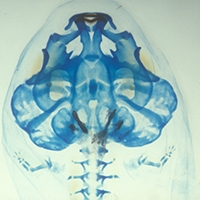Citation:
| 1.81 MB |
Date Published:
NovAbstract:
We utilize a novel, transgenic cell-labeling system to assess the embryonic derivation of cartilages in the post-metamorphic skull of anuran amphibians. Many of these cartilages form de novo at metamorphosis and have no obvious precursors within the larval skeleton. Most adult cartilages are derived from mandibular- or hyoid-stream neural crest, either individually or in combination; branchial-stream neural crest makes a modest contribution. Each stream also contributes to at least one cartilage in the middle ear or external ear. Four cartilages are composite elements; each is derived from at least two distinct cell populations. Many boundaries between adjacent neural-crest territories are cryptic insofar as they do not coincide with anatomical boundaries. The system of adult cranial segmentation revealed by these fate-mapping results differs in important respects from both the segmentation of the ontogenetically earlier larval skull and the cranial segmentation in amniotes. Most striking is the rostral inversion of neural-crest-derived cartilages in Xenopus, such that mandibular stream-derived elements are deployed caudal to those derived from the hyoid stream, which predominate anteriorly. This novel pattern of rostral segmentation may be a consequence of the complex, biphasic life history that is characteristic of most species of living amphibians, and especially anurans, in which cranial architecture is significantly reconfigured at metamorphosis. Neural-crest derivation of the vertebrate skull is not invariant; instead, embryonic derivation of individual components of the cranial skeleton may vary widely among species.
Notes:
373OITimes Cited:10Cited References Count:71






